
- •Preface
- •About This Book
- •Acknowledgments
- •Contents at a Glance
- •Contents
- •Relaxing at the Beach
- •Dressing the Scene
- •Animating Motion
- •Rendering the Final Animation
- •Summary
- •The Interface Elements
- •Using the Menus
- •Using the Toolbars
- •Using the Viewports
- •Using the Command Panel
- •Using the Lower Interface Bar Controls
- •Interacting with the Interface
- •Getting Help
- •Summary
- •Understanding 3D Space
- •Using the Viewport Navigation Controls
- •Configuring the Viewports
- •Working with Viewport Backgrounds
- •Summary
- •Working with Max Scene Files
- •Setting File Preferences
- •Importing and Exporting
- •Referencing External Objects
- •Using the File Utilities
- •Accessing File Information
- •Summary
- •Customizing Modify and Utility Panel Buttons
- •Working with Custom Interfaces
- •Configuring Paths
- •Selecting System Units
- •Setting Preferences
- •Summary
- •Creating Primitive Objects
- •Exploring the Primitive Object Types
- •Summary
- •Selecting Objects
- •Setting Object Properties
- •Hiding and Freezing Objects
- •Using Layers
- •Summary
- •Cloning Objects
- •Understanding Cloning Options
- •Mirroring Objects
- •Cloning over Time
- •Spacing Cloned Objects
- •Creating Arrays of Objects
- •Summary
- •Working with Groups
- •Building Assemblies
- •Building Links between Objects
- •Displaying Links and Hierarchies
- •Working with Linked Objects
- •Summary
- •Using the Schematic View Window
- •Working with Hierarchies
- •Setting Schematic View Preferences
- •Using List Views
- •Summary
- •Working with the Transformation Tools
- •Using Pivot Points
- •Using the Align Commands
- •Using Grids
- •Using Snap Options
- •Summary
- •Exploring the Modifier Stack
- •Exploring Modifier Types
- •Summary
- •Exploring the Modeling Types
- •Working with Subobjects
- •Modeling Helpers
- •Summary
- •Drawing in 2D
- •Editing Splines
- •Using Spline Modifiers
- •Summary
- •Creating Editable Mesh and Poly Objects
- •Editing Mesh Objects
- •Editing Poly Objects
- •Using Mesh Editing Modifiers
- •Summary
- •Introducing Patch Grids
- •Editing Patches
- •Using Modifiers on Patch Objects
- •Summary
- •Creating NURBS Curves and Surfaces
- •Editing NURBS
- •Working with NURBS
- •Summary
- •Morphing Objects
- •Creating Conform Objects
- •Creating a ShapeMerge Object
- •Creating a Terrain Object
- •Using the Mesher Object
- •Working with BlobMesh Objects
- •Creating a Scatter Object
- •Creating Connect Objects
- •Modeling with Boolean Objects
- •Creating a Loft Object
- •Summary
- •Understanding the Various Particle Systems
- •Creating a Particle System
- •Using the Spray and Snow Particle Systems
- •Using the Super Spray Particle System
- •Using the Blizzard Particle System
- •Using the PArray Particle System
- •Using the PCloud Particle System
- •Using Particle System Maps
- •Controlling Particles with Particle Flow
- •Summary
- •Understanding Material Properties
- •Working with the Material Editor
- •Using the Material/Map Browser
- •Using the Material/Map Navigator
- •Summary
- •Using the Standard Material
- •Using Shading Types
- •Accessing Other Parameters
- •Using External Tools
- •Summary
- •Using Compound Materials
- •Using Raytrace Materials
- •Using the Matte/Shadow Material
- •Using the DirectX 9 Shader
- •Applying Multiple Materials
- •Material Modifiers
- •Summary
- •Understanding Maps
- •Understanding Material Map Types
- •Using the Maps Rollout
- •Using the Map Path Utility
- •Using Map Instances
- •Summary
- •Mapping Modifiers
- •Using the Unwrap UVW modifier
- •Summary
- •Working with Cameras
- •Setting Camera Parameters
- •Summary
- •Using the Camera Tracker Utility
- •Summary
- •Using Multi-Pass Cameras
- •Creating Multi-Pass Camera Effects
- •Summary
- •Understanding the Basics of Lighting
- •Getting to Know the Light Types
- •Creating and Positioning Light Objects
- •Viewing a Scene from a Light
- •Altering Light Parameters
- •Working with Photometric Lights
- •Using the Sunlight and Daylight Systems
- •Using Volume Lights
- •Summary
- •Selecting Advanced Lighting
- •Using Local Advanced Lighting Settings
- •Tutorial: Excluding objects from light tracing
- •Summary
- •Understanding Radiosity
- •Using Local and Global Advanced Lighting Settings
- •Working with Advanced Lighting Materials
- •Using Lighting Analysis
- •Summary
- •Using the Time Controls
- •Working with Keys
- •Using the Track Bar
- •Viewing and Editing Key Values
- •Using the Motion Panel
- •Using Ghosting
- •Animating Objects
- •Working with Previews
- •Wiring Parameters
- •Animation Modifiers
- •Summary
- •Understanding Controller Types
- •Assigning Controllers
- •Setting Default Controllers
- •Examining the Various Controllers
- •Summary
- •Working with Expressions in Spinners
- •Understanding the Expression Controller Interface
- •Understanding Expression Elements
- •Using Expression Controllers
- •Summary
- •Learning the Track View Interface
- •Working with Keys
- •Editing Time
- •Editing Curves
- •Filtering Tracks
- •Working with Controllers
- •Synchronizing to a Sound Track
- •Summary
- •Understanding Your Character
- •Building Bodies
- •Summary
- •Building a Bones System
- •Using the Bone Tools
- •Using the Skin Modifier
- •Summary
- •Creating Characters
- •Working with Characters
- •Using Character Animation Techniques
- •Summary
- •Forward versus Inverse Kinematics
- •Creating an Inverse Kinematics System
- •Using the Various Inverse Kinematics Methods
- •Summary
- •Creating and Binding Space Warps
- •Understanding Space Warp Types
- •Combining Particle Systems with Space Warps
- •Summary
- •Understanding Dynamics
- •Using Dynamic Objects
- •Defining Dynamic Material Properties
- •Using Dynamic Space Warps
- •Using the Dynamics Utility
- •Using the Flex Modifier
- •Summary
- •Using reactor
- •Using reactor Collections
- •Creating reactor Objects
- •Calculating and Previewing a Simulation
- •Constraining Objects
- •reactor Troubleshooting
- •Summary
- •Understanding the Max Renderers
- •Previewing with ActiveShade
- •Render Parameters
- •Rendering Preferences
- •Creating VUE Files
- •Using the Rendered Frame Window
- •Using the RAM Player
- •Reviewing the Render Types
- •Using Command-Line Rendering
- •Creating Panoramic Images
- •Getting Printer Help
- •Creating an Environment
- •Summary
- •Creating Atmospheric Effects
- •Using the Fire Effect
- •Using the Fog Effect
- •Summary
- •Using Render Elements
- •Adding Render Effects
- •Creating Lens Effects
- •Using Other Render Effects
- •Summary
- •Using Raytrace Materials
- •Using a Raytrace Map
- •Enabling mental ray
- •Summary
- •Understanding Network Rendering
- •Network Requirements
- •Setting up a Network Rendering System
- •Starting the Network Rendering System
- •Configuring the Network Manager and Servers
- •Logging Errors
- •Using the Monitor
- •Setting up Batch Rendering
- •Summary
- •Compositing with Photoshop
- •Video Editing with Premiere
- •Video Compositing with After Effects
- •Introducing Combustion
- •Using Other Compositing Solutions
- •Summary
- •Completing Post-Production with the Video Post Interface
- •Working with Sequences
- •Adding and Editing Events
- •Working with Ranges
- •Working with Lens Effects Filters
- •Summary
- •What Is MAXScript?
- •MAXScript Tools
- •Setting MAXScript Preferences
- •Types of Scripts
- •Writing Your Own MAXScripts
- •Learning the Visual MAXScript Editor Interface
- •Laying Out a Rollout
- •Summary
- •Working with Plug-Ins
- •Locating Plug-Ins
- •Summary
- •Low-Res Modeling
- •Using Channels
- •Using Vertex Colors
- •Rendering to a Texture
- •Summary
- •Max and Architecture
- •Using AEC Objects
- •Using Architectural materials
- •Summary
- •Tutorial: Creating Icy Geometry with BlobMesh
- •Tutorial: Using Caustic Photons to Create a Disco Ball
- •Summary
- •mental ray Rendering System
- •Particle Flow
- •reactor 2.0
- •Schematic View
- •BlobMesh
- •Spline and Patch Features
- •Import and Export
- •Shell Modifier
- •Vertex Paint and Channel Info
- •Architectural Primitives and Materials
- •Minor Improvements
- •Choosing an Operating System
- •Hardware Requirements
- •Installing 3ds max 6
- •Authorizing the Software
- •Setting the Display Driver
- •Updating Max
- •Moving Max to Another Computer
- •Using Keyboard Shortcuts
- •Using the Hotkey Map
- •Main Interface Shortcuts
- •Dialog Box Shortcuts
- •Miscellaneous Shortcuts
- •System Requirements
- •Using the CDs with Windows
- •What’s on the CDs
- •Troubleshooting
- •Index
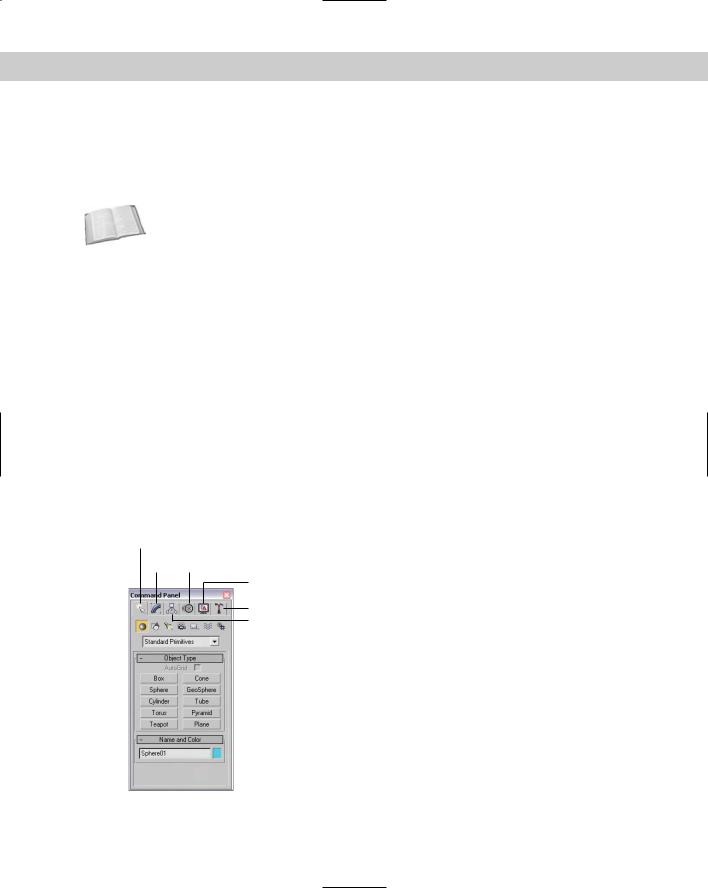
42 |
Part I Learning the Max Interface |
Using the Viewports
The four viewports make up the largest area of the entire interface and provide a way of viewing the objects within the scene. Each of the viewports is configurable and can be unique from the others.
Cross- Understanding how to work with the viewports is vital to accomplishing tasks with Max, so Reference viewports have an entire chapter dedicated just to them — Chapter 2, “Seeing It All — Working
with the Viewports.”
Using the Command Panel
If there is one place in Max, besides the viewports, where you’ll spend all your time, it’s the Command Panel (at least until you’re comfortable enough with the quadmenus). The Command Panel is located to the right of the viewports along the right edge of the interface. This is where the object parameters, settings, and controls are located. The Command Panel is split into six panels, each accessed via a tab icon located at its top. These six tabs are Create, Modify, Hierarchy, Motion, Display, and Utilities.
You can pull away the Command Panel from the right window edge as a floating dialog box, as shown in Figure 1-5, by clicking on the open space to the right of the tabbed icons at the top of the Command Panel and dragging away from the interface edge. You can also dock it to the left window edge, which is really handy if you’re left-handed. While it’s a floating panel, you can resize the Command Panel by dragging on its edges or corners.
After you’ve pulled it away from the interface, you can re-dock it to its last position by dou- ble-clicking on its title bar. You can also right-click on the title bar to access the pop-up menu to Dock (either Left or Right), Float, Customize, or hide the Command Panel.
Create
Modify Motion
Display
Utilities
Hierarchy
Figure 1-5: The Command Panel includes six separate panels accessed via tab icons.
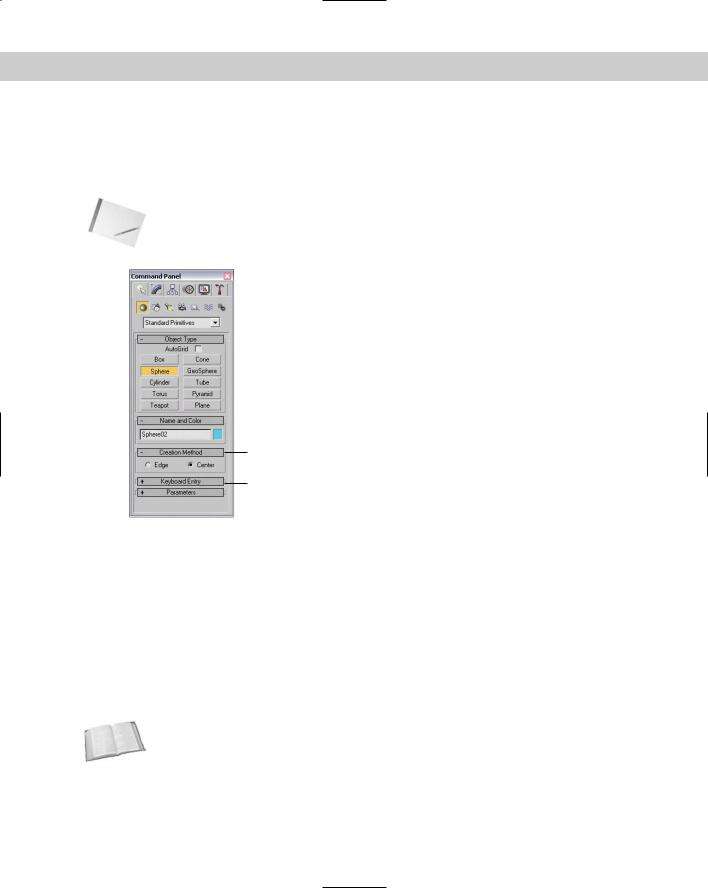
Chapter 1 Finding Your Way — Exploring the Max Interface |
43 |
Most of the controls, buttons, and parameters in the Command Panel are contained within sections called rollouts. A rollout is a grouping of controls positioned under a gray, boxed title, as shown in Figure 1-6. Each rollout title bar includes a plus or minus sign (a minus sign indicates that the rollout is open; a plus sign shows closed rollouts). Clicking the rollout title opens or closes the rollout. You can also reposition the order of the rollouts by dragging the rollout title and dropping it above or below the other rollouts.
Note |
You cannot reposition some of the rollouts, such as the Object Type and the Name and Color |
|
rollouts found in the Create panel. |
Opened rollout
Closed rollout
Figure 1-6: Open and close rollouts by clicking on the rollout title.
Right-clicking away from the buttons in a rollout presents a pop-up menu where you can select to close the rollout you’ve clicked in, Close All, Open All, or Reset Rollout Order. The pop-up menu also lists all available rollouts within the current panel with a check mark next to the ones that are open.
Expanding all the rollouts often exceeds the screen space allotted to the Command Panel. If the rollouts exceed the given space, then a small vertical scroll bar appears at the right edge of the Command Panel. You can drag this scroll bar to access the rollouts at the bottom of the Command Panel, or you can click away from the controls when a hand cursor appears. With the hand cursor, click and drag in either direction to scroll the Command Panel. You can also scroll the Command Panel with the scroll wheel.
Cross- |
You can customize the Command Panel like the other toolbars. Customizing the Command |
Reference |
Panel is covered in Chapter 4, “Customizing the Max Interface and Setting Preferences.” |
|
The Command Panel can also be doubled or tripled (or any multiple as long as you have room) in width by dragging its left edge toward the center of the interface. The width of the Command Panel is increased at the expense of the viewports. Figure 1-7 shows the Command Panel double its normal size.
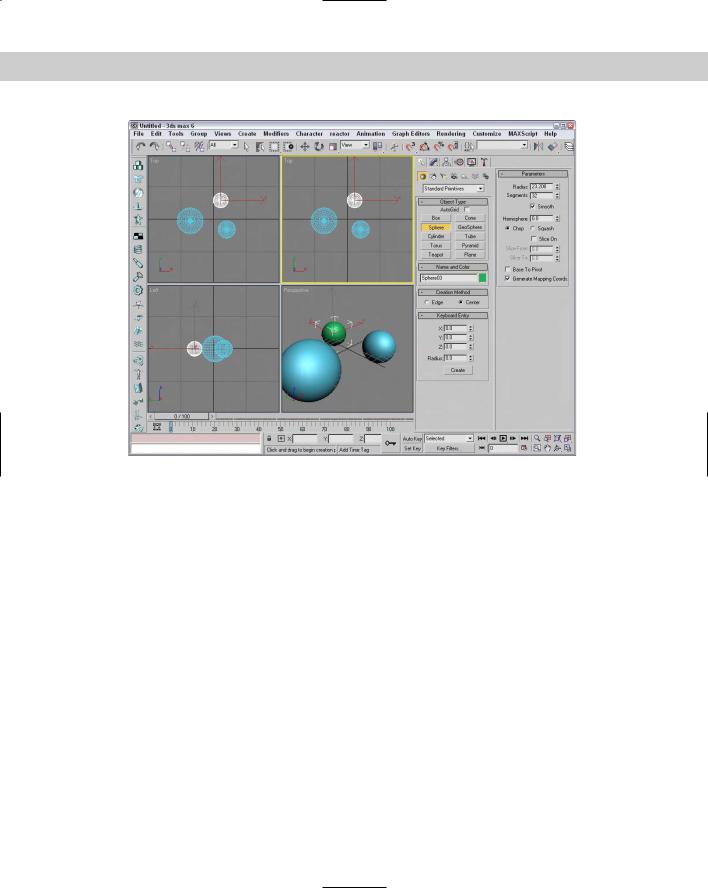
44 |
Part I Learning the Max Interface |
Figure 1-7: Increase the width of the Command Panel by dragging its left edge.
Tutorial: Rearranging the interface for lefties
I used to work for a company that required that all computers have the mouse to the left of the keyboard. We swapped computers often, and the boss felt that this would enable us to work the mouse and the keypad at the same time (and you thought your work environment was weird). The reality is that some people like it on the left and others prefer it on the right, and Max can accommodate both.
With the Command Panel on the right side of the interface, the default Max interface obviously favors right-handers, but with the docking panels, you can quickly change it to be friendly to lefties.
To rearrange the interface to make it friendly for lefties, follow these steps:
1.Click the Command Panel on the empty space to the right of the Utilities tab, and drag toward the center of the interface. As you drag the Command Panel away from the right edge, the cursor changes.
2.Continue to drag the Command Panel to the left edge, and the cursor changes again to indicate that it will be docked when released. Release the mouse button, and the Command Panel docks to the left side.
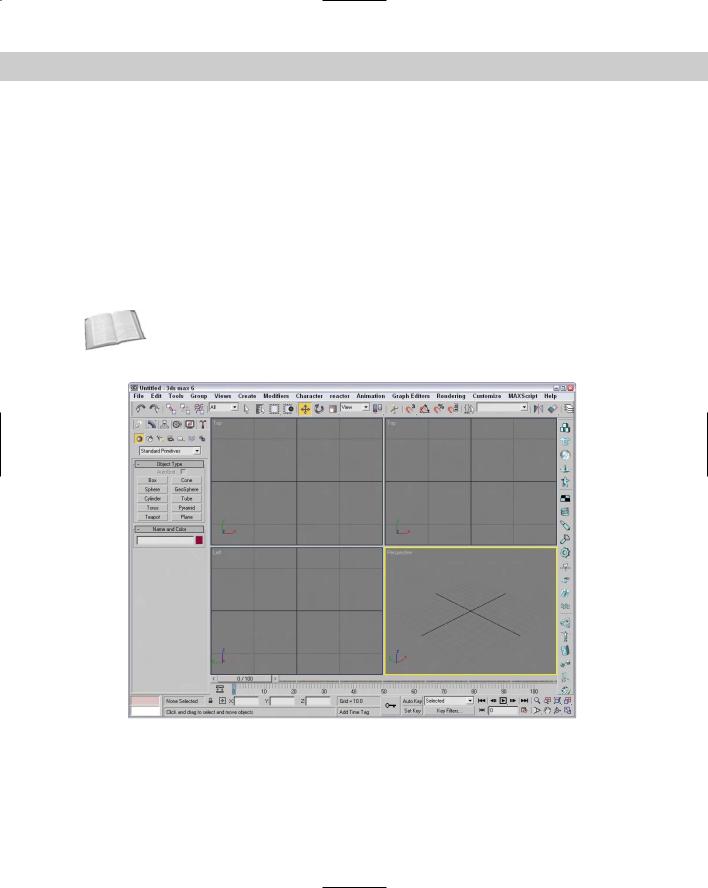
Chapter 1 Finding Your Way — Exploring the Max Interface |
45 |
3.For an even easier method, you can right-click on the Command Panel’s title bar and select Dock Left from the pop-up menu.
4.Next dock the reactor toolbar on the right side by dragging it from the left to the right. Figure 1-8 shows the rearranged interface ready for all you southpaws.
Create panel
The Create panel is the place you go to create objects for the scene. These objects could be geometric objects like spheres, cones, and boxes or other objects like lights, cameras, or Space Warps. The Create panel contains a huge variety of objects. To create an object, you simply need to find the button for the object that you want to create, click it, click in one of the viewports, and voilá — instant object.
Cross- |
Creating objects is covered in detail in chapters throughout the rest of the book, but the first |
Reference |
chapter that really gets into creating objects is Chapter 5, “Creating and Editing Primitive |
|
|
|
Objects.” You can buzz over to that chapter if you are anxious to start creating things. |
Figure 1-8: Left-handed users can move the Command Panel to the left side.
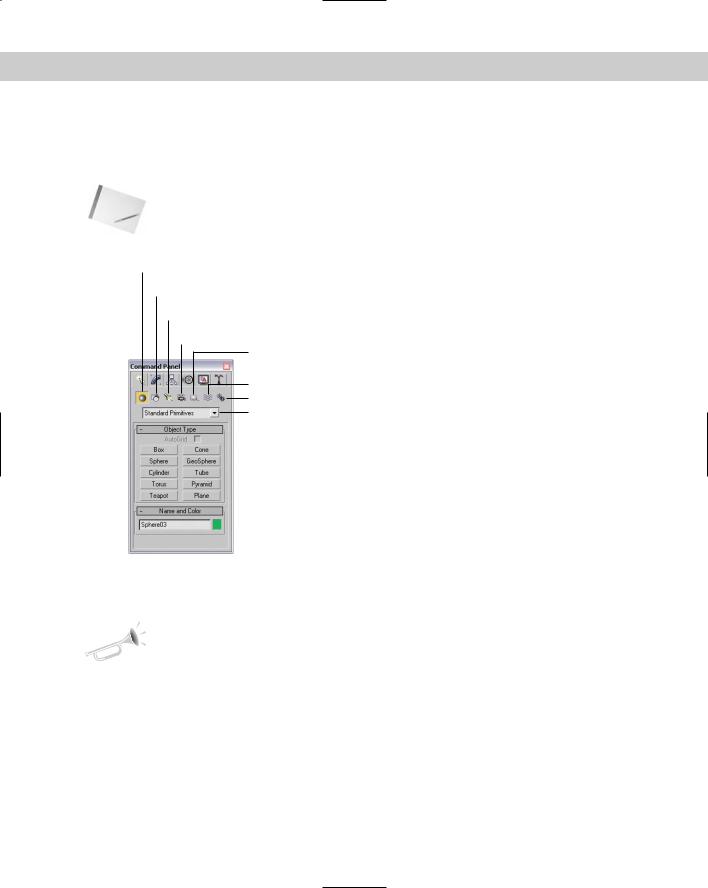
46 |
Part I Learning the Max Interface |
The Create panel includes several categories and subcategories of objects. The categories, shown in Figure 1-9, are displayed as icons directly under the Command Panel tabs. The categories include Geometry, Shapes, Lights, Cameras, Helpers, Space Warps, and Systems. Subcategories are displayed in the drop-down list under the category icons. Each subcategory displays a different set of buttons in the Object Type rollout when selected.
Note Selecting an object from the Create menu automatically opens the Create panel and selects the requested object type.
Geometry
Shapes
Lights
Cameras
Helpers
Space Warps Systems Sub-category drop-down list
Figure 1-9: The Create panel includes seven different categories of objects.
Table 1-5 lists all the available Create panel buttons for each category and subcategory.
New |
Many new items were added to the Create panel including the BlobMesh compound object |
Feature |
and all the AEC Objects such as Foliage, Railing, Wall, Doors, Windows, and Stairs. Other new |
|
|
|
features include the mental ray Area Omni and Area Spot lights, the Assembly Heads, Particle |
|
Flow, reactor Helper subcategories, and the reactor and Particles & Dynamics Space Warps |
|
subcategories. |
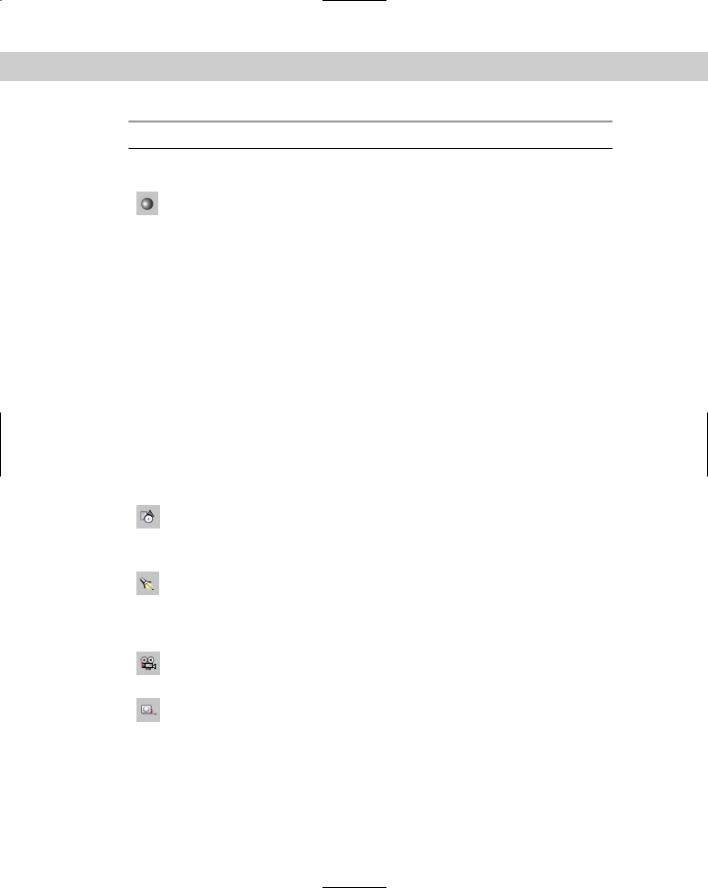
Chapter 1 Finding Your Way — Exploring the Max Interface |
47 |
Table 1-5: Command Panel Buttons per Subcategory
|
Subcategory |
|
Category (icon) |
(drop-down list) |
Available Buttons |
|
|
|
|
Standard Primitives |
Box, Cone, Sphere, GeoSphere, Cylinder, |
|
|
Tube, Torus, Pyramid, Teapot, Plane |
Geometry |
|
|
|
Extended Primitives |
Hedra, Torus Knot, ChamferBox, ChamferCyl, |
|
|
OilTank, Capsule, Spindle, L-Ext, Gengon, C- |
|
|
Ext, RingWave, Hose, Prism |
|
Compound Objects |
Morph, Scatter, Conform, Connect, BlobMesh, |
|
|
ShapeMerge, Boolean, Terrain, Loft, Mesher |
|
Particle Systems |
PF Source, Spray, Snow, Blizzard, PArray, |
|
|
PCloud, Super Spray |
|
Patch Grids |
Quad Patch, Tri Patch |
|
NURBS Surfaces |
Point Surf, CV Surf |
|
AEC Extended |
Foliage, Railing, Wall |
|
Dynamics Objects |
Damper, Spring |
|
Stairs |
Straight Stair |
|
Doors |
Pivot, Sliding, BiFold |
|
Windows |
Awning, Casement, Fixed, Pivoted, Projected, |
|
|
Sliding |
|
Splines |
Line, Rectangle, Circle, Ellipse, Arc, Donut, |
|
|
NGon, Star, Text, Helix, Section |
Shapes |
|
|
|
NURBS Curves |
Point Curve, CV Curve |
|
Standard |
Target Spot, Free Spot, Target Direct, |
|
|
Free Direct, Omni, Skylight, mr Area Omni, |
Lights |
|
mr Area Spot |
|
Photometric |
Target Point, Free Point, Target Linear, Free |
|
|
Linear, Target Area, Free Area, IES Sun, IES Sky |
|
Standard |
Target, Free |
Cameras |
|
|
|
Standard |
Dummy, Grid, Point, Tape, Protractor, |
|
|
Compass |
Helpers |
|
|
|
Atmospheric Apparatus |
BoxGizmo, SphereGizmo, CylGizmo |
|
Camera Match |
CamPoint |
|
Assembly Heads |
Luminaire |
Continued
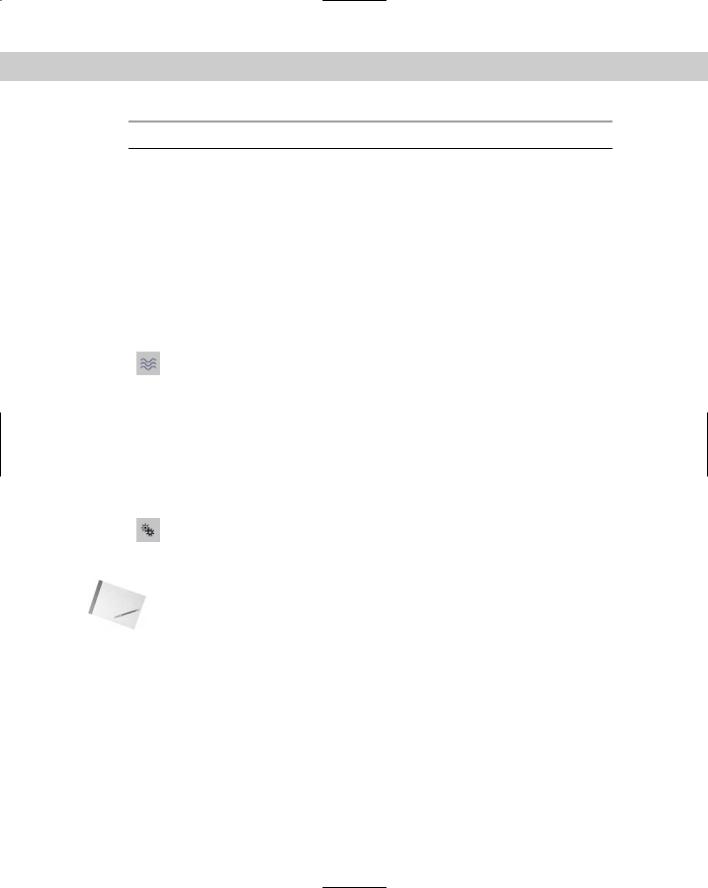
48 |
Part I Learning the Max Interface |
Table 1-5 (continued)
|
Subcategory |
|
Category (icon) |
(drop-down list) |
Available Buttons |
|
|
|
|
Manipulators |
Cone Angle, Plane Angle, Slider |
|
Particle Flow |
SpeedByIcon, Find Target |
|
VRML97 |
Anchor, AudioClip, Background, Billboard, |
|
|
Fog, Inline, LOD, NavInfo, ProxSensor, Sound, |
|
|
TimeSensor, TouchSensor |
|
reactor |
RBCollection, Csolver, Point-Point, Point-Path, |
|
|
Hinge, Ragdoll, Carwheel, Prismatic, L |
|
|
Dashpot, A Dashpot, CLCollection, |
|
|
DMCollection, RPCollection, SBCollection, |
|
|
Fracture, Motor, Plane, Spring, Toy Car, Wind |
|
Forces |
Motor, Push, Vortex, Drag, Path Follow, |
|
|
PBomb, Displace, Gravity, Wind |
Space Warps |
|
|
|
Deflectors |
PDynaFlect, POmniFlect, SDynaFlect, |
|
|
SOmniFlect, UDynaFlect, UOmniFlect, |
|
|
SDeflector, UDeflector, Deflector |
|
Geometric/Deformable |
FFD (Box), FFD (Cyl), Wave, Ripple, Displace, |
|
|
Conform, Bomb |
|
Modifier-Based |
Bend, Noise, Skew, Taper, Twist, Stretch |
|
reactor |
Water |
|
Standard |
Bones, Ring Array, Sunlight, Daylight |
Systems |
|
|
|
|
|
Note For the most part, the Create panel and the Create menu are the same, but there are a couple of differences. The biggest difference is the order of many of the items. In addition, the Extended Primitives Gengon object was left out of the Create menu. Oops.
Below the Object Type rollout is the Name and Color rollout. Every object created with the Create panel is given a default name and color. Using this rollout, you can change the object name and color. The color is used to display the object in the viewports if no material is applied. Both the Object Type and Name and Color rollouts are visible in all the categories found in the Create panel.
After you select a button, the button is highlighted yellow and several additional rollouts magically appear. These new rollouts hold the parameters for the selected object and are displayed in the Create panel below the Name and Color rollout. Altering these parameters changes the object. The button remains selected, allowing you to create more objects until you select a different button, click on a toolbar button, or right-click in the active viewport.
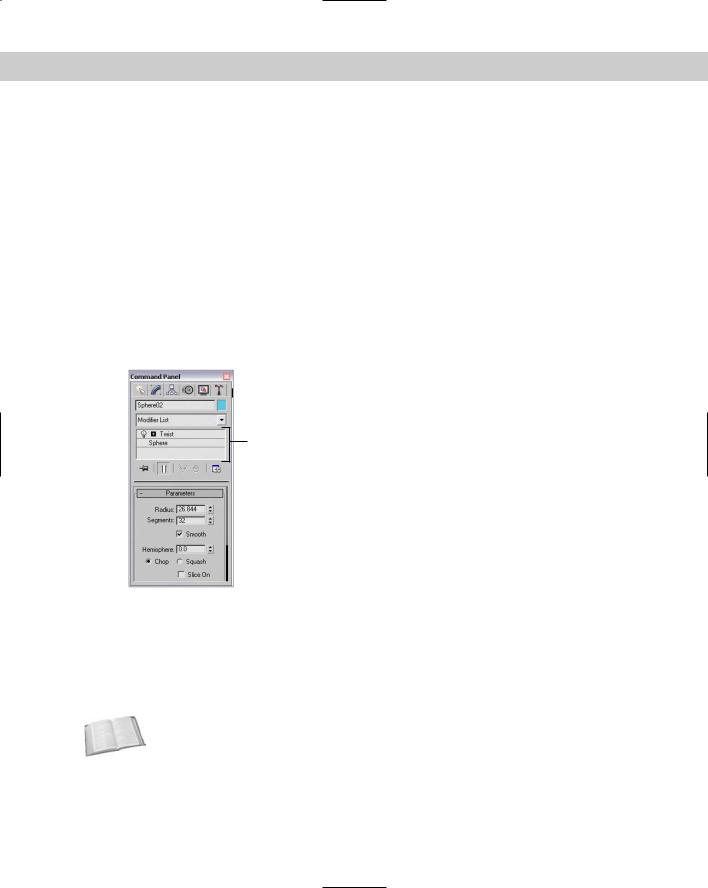
Chapter 1 Finding Your Way — Exploring the Max Interface |
49 |
Modify panel
The parameters found in the Create panel are great for changing an object, but they are available only while you’re creating the object. If you select another object and then return to the Create panel with the first object selected, all its parameters are gone. Actually, they aren’t gone, but rather they’ve migrated to the Modify panel. The Modify panel is the permanent location of object parameters.
In addition to modifying object parameters, you can use the Modify panel to apply modifiers to the selected object. Modifiers are parameter-driven functions for modifying an object. You can see a complete list of modifiers in the Modifier List drop-down list (or in the Modifiers menu).
Once applied, you can control the modifiers via parameters displayed in the Modify panel. All modifiers that are applied to an object are displayed in the Modifier Stack (like the Twist modifier applied to a sphere object in Figure 1-10), which appears at the top of the Modify panel (directly under the Modifier List drop-down list). You can also apply modifiers using the Modifiers menu.
Modifier Stack
Figure 1-10: Use the Modify panel to apply modifiers and to modify object parameters.
The Modifier Stack is like an object’s medical history: It details everything that has happened to an object. The Modifier Stack displays all modifiers that have been applied to the current selected object. This stack lets you revisit any modifier and change its parameters, reorder it in the stack, or delete it.
Cross-
Reference
An introduction to modifiers is presented in Chapter 11, “Introducing Modifiers for Basic Object Deformation,” but you can find coverage of other modifiers sprinkled throughout the rest of the chapters. For example, see Chapter 24, “Working with Cameras,” for coverage of the Camera Correction modifier.
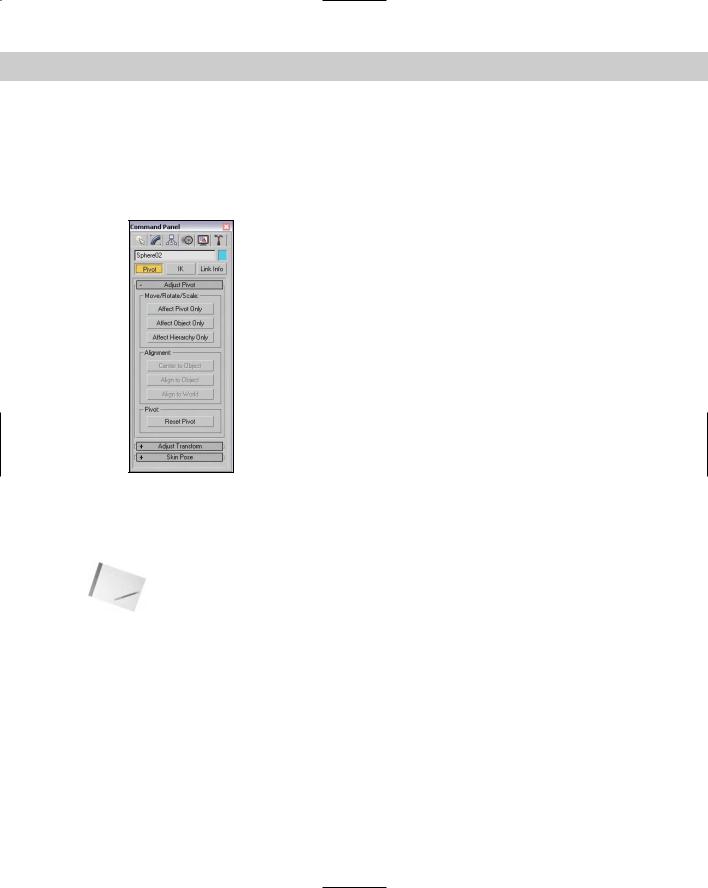
50 |
Part I Learning the Max Interface |
Hierarchy panel
The Hierarchy panel, shown in Figure 1-11, includes three different sets of controls. You access them by using the three buttons located at the top of the panel. These sets are Pivot, Inverse Kinematics (IK), and Link Info. Each of these buttons when selected presents several different rollouts of parameters.
Figure 1-11: The Hierarchy panel offers controls for adjusting pivot points, among other things.
The Pivot button opens rollouts that let you move and reorient an object’s pivot point. A pivot point is the point about which transformations are applied. The IK button opens rollouts that let you set up an inverse kinematics structure and to define how the joints of such a structure can move. Finally, the Link Info button opens rollouts for setting locks, which prevent an object from moving, rotating, or scaling along certain axes.
Note |
Check out the details on pivots in Chapter 10, “Transforming Objects — Translate, Rotate, and |
|
Scale,” Inverse Kinematics in Chapter 37, “Using Inverse Kinematics,” and links in Chapter 8, |
|
“Grouping and Linking Objects.” |
Motion panel
Similar to the Hierarchy panel, the Motion panel has a dual personality. The two buttons at the top of the Motion panel, shown in Figure 1-12, are Parameters and Trajectories. One common way of modifying object motion is to apply Controllers and Constraints. The Parameters button opens several rollouts that enable you to apply animation Controllers and Constraints.

Chapter 1 Finding Your Way — Exploring the Max Interface |
51 |
Controllers affect the position, rotation, and scaling of objects in preset ways, and Constraints limit the motion of an object. You can access a list of Controllers by clicking the Assign Controller button positioned at the top of the Assign Controller rollout or by choosing one from the Animation menu.
Assign Controller button
Figure 1-12: The Motion panel offers an interface for assigning animation Controllers to an object.
The Trajectories button opens a single rollout that lets you set parameters for the animation path.
Cross- |
Constraints and Controllers are the subjects of Chapter 31, “Animating with Constraints and |
Reference |
Controllers.” Trajectories are covered in Chapter 30, “Animation Basics.” |
|
Display panel
The Display panel, shown in Figure 1-13, controls how objects are seen within the viewports. You can set display parameters for individual objects. Using this panel, you can hide or freeze objects and modify all display parameters. Many of these same commands are found in the Display Floater and in the Object Properties dialog box.
Cross- |
I cover the Display panel in Chapter 6, “Selecting Objects and Setting Object Properties.” |
Reference |
|
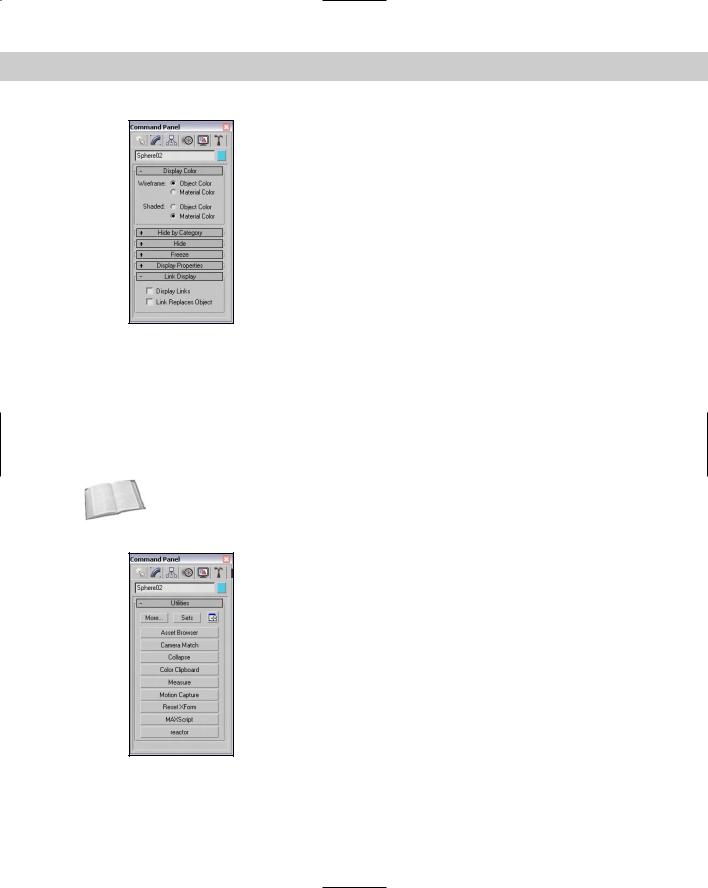
52 |
Part I Learning the Max Interface |
Figure 1-13: The Display panel includes settings for the color of the object.
Utilities panel
You can find an assortment of miscellaneous tools in the Utilities panel, shown in Figure 1-14. The default utilities include the Asset Browser, Camera Match, Collapse, Color Clipboard, Measure, Motion Capture, Reset XForm, MAXScript, and reactor. Click the More button at the top of the Utilities panels to open an additional list of utilities. To execute a utility, simply click its button or select it from the list. Some utilities open dialog boxes, and others present rollouts in the bottom of the Utilities panel. The button for the selected utility is highlighted in yellow.
Cross-
Reference
This panel also includes the Configure Button Sets button for customizing which buttons appear in the default Utilities rollout. See Chapter 4, “Customizing the Max Interface and Setting Preferences,” for more information.
Figure 1-14: The Utilities panel includes several miscellaneous tools.
